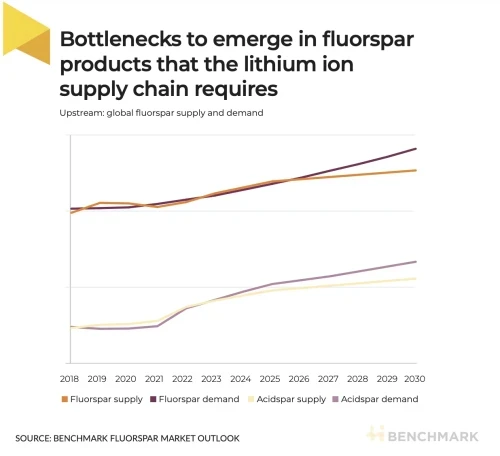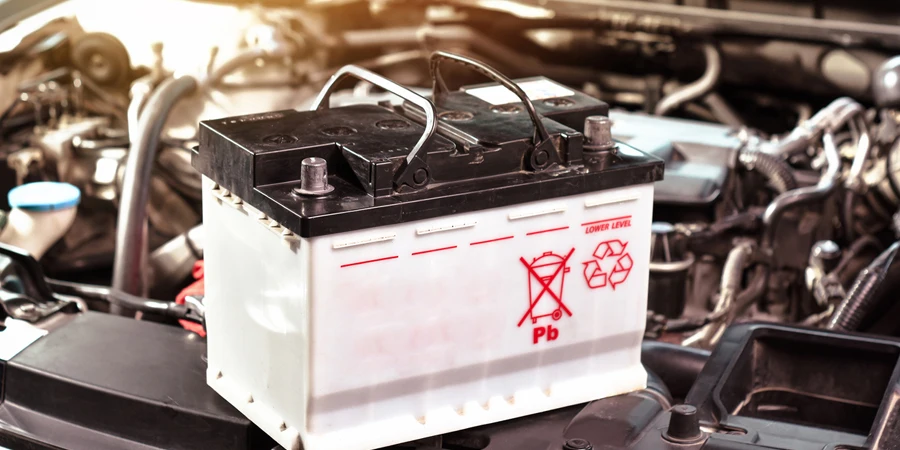Fluorspar demand from the lithium-ion battery sector is expected to exceed 1.6 million tonnes by 2030, representing a significant portion of the overall market, according to Benchmark’s new Fluorspar Market Outlook.
This mineral, primarily composed of calcium fluoride (CaF2), holds potential beyond its traditional uses in refrigerants, steelmaking and aluminum production. Fluorspar is mainly produced through open pit operations and has two main grades: metallurgical-grade (metspar) for steelmaking and acid-grade (acidspar). The material is extracted and then processed through crushing, grinding, and physical sorting.
Acidspar requires further chemical refining to reach 97% CaF2 content. The final product is sold in a powder form and transported either as dry or wet filtercake, depending on the shipping routes and end-market.
As the lithium-ion battery market experiences massive growth fueled by electric vehicles and renewable energy storage, fluorspar’s properties are finding increasing application in four key areas:
- Polyvinylidene fluoride (PVDF) binder in cathodes: PVDF, a fluoropolymer derived from fluorspar, serves as the critical binder material holding cathode active materials together. Its excellent performance in high-voltage batteries and resistance to harsh chemical environments make it irreplaceable. The growing demand for high-nickel cathodes, with their superior energy density, further boosts PVDF consumption.
- PVDF coating on separators in pouch-format cells: Pouch cells, popular in consumer electronics and smaller battery applications, employ separators coated with PVDF to enhance their stability and safety. This application, though currently smaller than cathode binder use, is witnessing rapid growth due to the rising popularity of pouch cells.
- Lithium hexafluorophosphate (LiPF6) electrolyte: LiPF6 serves as the key electrolyte salt in lithium ion batteries, facilitating lithium ion movement. Its production relies heavily on hydrofluoric acid (HF), which is derived from fluorspar. The surging demand for lithium ion batteries directly translates to increased LiPF6 and, consequently, fluorspar consumption.
- Hydrofluoric acid for anode purification: Natural flake graphite, a common anode material, often contains impurities like silica. HF plays a crucial role in removing these impurities, enhancing the performance and safety of the anode. As demand for high-purity graphite increases, so does the reliance on HF and, subsequently, fluorspar.

This growing demand presents opportunities for the fluorspar industry. However, challenges remain, according to Benchmark.
- Supply constraints: Current fluorspar production is largely concentrated in a few countries, raising concerns about potential supply bottlenecks. Additionally, stringent environmental regulations can hamper new mine development, further tightening supply. New, largescale, and high-grade mining projects can require large amounts of new capital which can present challenges in jurisdictions with high-risk profiles.
- Price volatility: Fluorspar prices have historically been volatile, impacted by factors such as geopolitical tensions and fluctuations in demand from other sectors. This volatility can create uncertainty for battery manufacturers and hinder long-term planning. Diversifying supply and improving price transparency will help to remove some of the uncertainty from this critical market.
- Sustainability concerns: Fluorspar mining and processing raise environmental concerns, necessitating responsible practices and the adoption of sustainable mining and processing technologies. Again, diversifying supply away from artisanal producers—particularly in China—is likely to improve the sustainability credentials of the industry. This is particularly true if additional supply can be funded in nations which already have an advanced and sophisticated mining industry.
Despite these challenges, the long-term outlook for fluorspar, particularly acidspar, is promising, Benchmark says. The crucial role it plays in lithium-ion battery production, coupled with growing demand for cleaner energy solutions, is driving innovation and investment in exploration, processing, and sustainable practices.
China dominates the fluorspar market, accounting for more than 60% of global production. However, companies such as Canada’s Sigma Lithium Resources and Western Australia’s Tivan are exploring new acidspar deposits with promising grades and economics.
Investments in recycling technologies for LiPF6 and PVDF could reduce reliance on virgin fluorspar in the long run. Benchmark expects process and end-of-life scrap of lithium ion batteries to increase strongly by 2040.
Research is underway to develop alternative fluorine sources, such as fluosilicic acid, to lessen dependence on fluorspar mining. Fluosilicic acid is a by-product of the phosphoric acid sector and some companies such as China’s Do-Fluoride are using it as feedstock for HF production, in place of acidspar.
A pure form of phosphoric acid (known as PPA) is a precursor to lithium iron phosphate (LFP) battery cathodes and phosphate rock mining is expected to grow 25% to 278 million tonnes by 2030, according to Benchmark.
Benchmark has just launched the new Fluorspar Market Outlook with detailed analysis of supply, demand and prices out to 2030.
Source from Green Car Congress
Disclaimer: The information set forth above is provided by greencarcongress.com independently of Alibaba.com. Alibaba.com makes no representation and warranties as to the quality and reliability of the seller and products.




